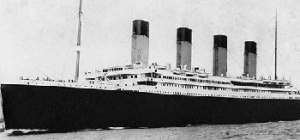Are cruise ships safe 100 years after Titanic?

Despite greatly improved safety records in the century since Titanic, the maritime industry faces new challenges driven by the continued growth of worldwide shipping, specialist marine insurer Allianz Global Corporate & Specialty (AGCS) has advised.
In the 100 years since the sinking of the Titanic, the world commercial shipping fleet has trebled to over 100,000 vessels, yet overall shipping loss rates have declined from one ship per 100 per year in 1912 to one ship per 670 per year in 2009.
While factors such as new technologies and regulation have tremendously improved marine safety, new risks have emerged. AGCS’s comprehensive report, ‘Safety and Shipping 1912-2012: From Titanic to Costa Concordia’, based on research from Cardiff University’s Seafarers’ International Research Centre (SIRC), highlights several key challenges for the industry including the growing trend to ‘super size’ ships and cost pressures pushing ship-owners to source crews from emerging economies where standards of training and assessment can be inconsistent.
Other significant safety risks include reduced crewing numbers which may compromise margins of safety and encourage ‘human error’ risks; increasing bureaucracy on board ships; the continued threat of piracy off Somalia and elsewhere; and the emergence of ice shipping and its associated navigational and environmental complications.
Commenting on the findings of the report, Dr Sven Gerhard, AGCS’s Global Product Leader Hull & Marine Liabilities, says: “While the seas are safer than ever today, the industry needs to address these new risks proactively. For example, ultra-large ships pose challenges for insurers due to their sheer size and value, while others raise concerns on structural integrity and failure. While scale alone does not make these ships riskier, the increased sizes introduce specific risks that need to be addressed, such as salvage and recovery considerations and emergency handling.”
ADVERTISEMENT
The largest modern container ships under construction are so big that there is space below deck for a basketball court, a full-sized American football stadium, and a spectator-filled ice hockey arena. Ships of this size raise questions of adequate loss coverage in the event of an incident and of potential structural limitations, says AGCS.
Human error – the weakest link
The report also highlights the continued challenge of human error in maritime operations – a factor which remains critical despite a hundred years of technological and regulatory improvements in safety. Over 75% of marine losses can be attributed to a wide range of ‘human error’ factors, including fatigue, inadequate risk management and competitive pressures, as well as potential deficiencies in training and crewing levels.
Dr Gerhard explains: “As technological improvements reduce risk, so does the weakest link in the system – the human factor – become more important. This is where the industry should focus most closely, so that best practice risk management and a culture of safety becomes second nature across the world fleet.”
Shipping disasters spur safety improvements
While technologies such as RADAR or Global Positioning Systems have driven improved safety, it has often been major accidents that have been the catalysts for key changes: for example, the 1914 SOLAS convention was triggered by the loss of the Titanic, and included regulations for ice navigation and life-saving equipment while the Herald of Free Enterprise disaster in 1987 spurred on the adoption of the International Safety Management code, which the International Maritime Organisation adopted in 1993 and which has done much to improve best safety practice.
“Historically, high profile shipping disasters have led to improvements in marine safety. And Costa Concordia is certain to be no different, whatever the result of the official investigations into this cause will be”, says Dr. Gerhard.
Key facts & figures from AGCS’s research on safety and shipping from 1912-2012:
* Since 1910, world fleet tonnage has increased by a factor of 23 and now approaches one billion gross tonnes (2010).
* World seaborne trade has trebled since 1970 to over 8.4 billion tonnes of cargo loaded per annum.
* Cruise passenger numbers have shown significant growth in recent years, and are forecast to grow by 7.4% year on year from 1990-2015. It is estimated that in 2015, over 22 million passengers will be carried on cruise vessels worldwide (2011: 19.2 million).
* Marine transport is one of the safest means of passenger transport overall with far lower fatal accident rates than car, motorcycle, bicycle or walking in Europe.
* Professional seafarer fatality rates have fallen in many countries: for example, in the UK, in 1919 it was estimated that there would be 358 fatal accidents for every 100,000 seafarer years spent ‘at risk’ – a rate which had fallen to 11 by the period 1996-2005. However, this fatality rate is still twelve times higher than in the general workforce.
* Accident ‘black spots’ include South China, Indo-China, Indonesia and Philippines with 17% of total losses in 2001-2011, followed by East Mediterranean and Black Sea (13%), and Japan, Korea and North China (12%). The seas around the British Isles also show relatively high loss concentrations (8%).
Technical innovations over the last 100 years include improved construction techniques, echo-sounding, RADAR, Very High Frequency radios, Automatic Radar Plotting Aid, satellite communications, GPS positioning finding, and Electronic Chart Display and Information Systems – all of which have supported marine safety.

